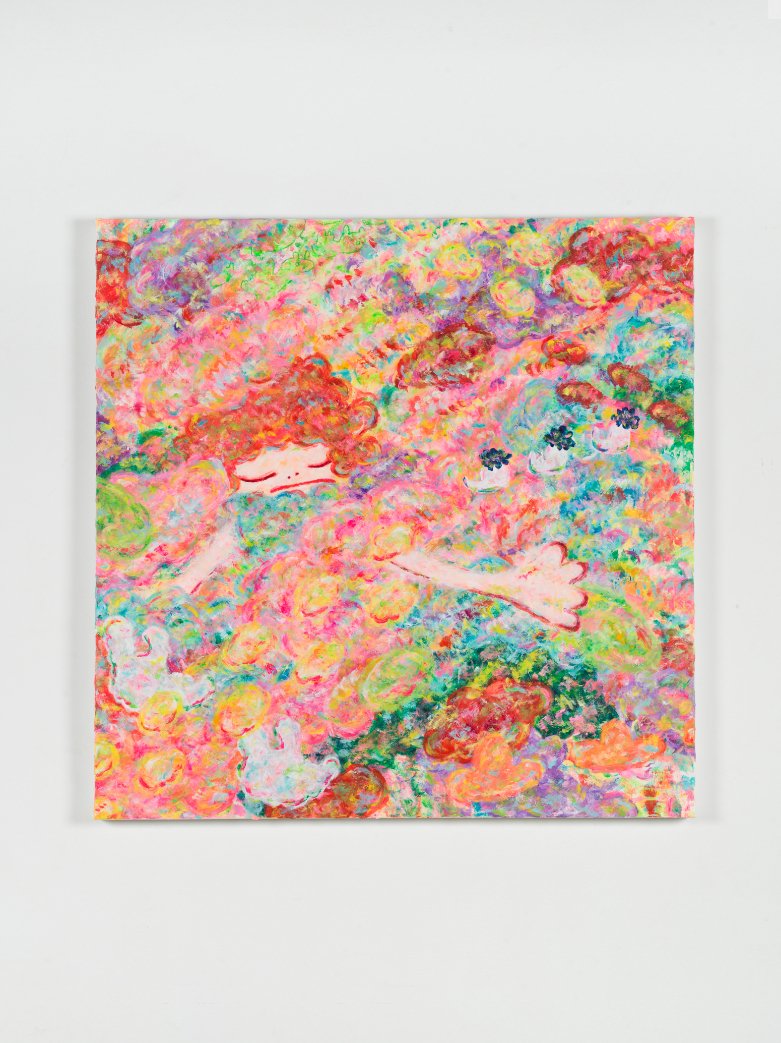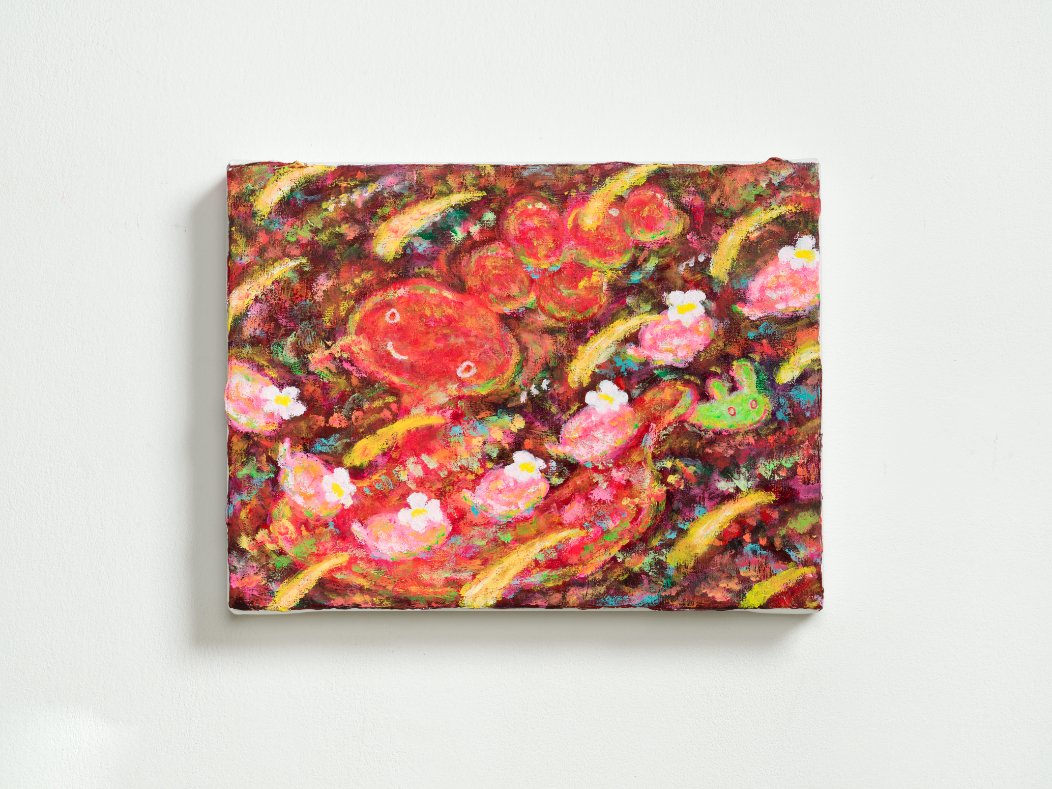AYA TAKANO’S “how far how deep we can go" exhibition at Perrotin in LA invites visitors into a mystical world which offers an escape and hope for a brighter existence.
AYA TAKANO 地球上のすべての生物のスピリット | the spirit of all life on earth, 2025. 130.3 x 162 x 3 cm | 51 5/16 x 63 3/4 x 1 3/16 inches. Oil on canvas. ©2025 AYA TAKANO/Kaikai Kiki Co., Ltd. All Rights Reserved. Courtesy Perrotin.
interview by Poppy Baring
Inspired by all art forms from Expressionism to the erotic art of Japan's Edo period, from manga artists such as Osamu Tezuka to Gustav Klimt, AYA TAKANO has been creating her own intimate fantasy since the age of three. Born in Japan in 1976, the painter, illustrator, and highly recognised Superflat artist welcomes LA residents to her new exhibition titled “how far how deep we can go”.
TAKANO presents otherworldly nymph-like characters that are extraterrestrial and yet still connected to and reflective of our reality. Drawing from the past and thinking to the future, she creates a limitless existence where time, gender, and age are undefined. Through various mediums, the Japanese artist investigates our inherent consciousness, exploring what it means to be marked by the past and connected to all life that occurred before us and will exist after us. Held in LA, home to spiritual seekers as well as recent environmental catastrophe, the exhibition offers a universe where all souls prosper as equals, a space where compassion prevails. In this interview, TAKANO provides insight into her worldview and her day-to-day life, asking visitors to look inwards and reconnect with the “radiance of all life.”
POPPY BARING: To start, how did the concept for “how deep how far we can go” begin? Was there a specific inspiration that made you want to investigate ancestral consciousness and speculative ecology?
AYA TAKANO: As I deepen my thoughts on the mysteries of the universe and life forms, as well as the mystery of consciousness—which I am exploring as the theme of my life—I came to feel that I want to depict a journey of fusion beneath the collective unconscious.
Los Angeles has a spiritual culture, and because [of] sad events such as wildfires, I thought it might be an ideal place to depict a journey of the heart.
I believe that each of us should travel within ourselves and create our own mythology. Personally, I hope for the creation of a mythology of coexistence, compassion, and bliss— something that breaks away from capitalism. I wanted to make it into an exhibition that encourages such a direction.
BARING: Also relating to the exhibition title, what does ‘depth’ mean to you, not just spiritually but also in terms of making, presenting and reacting to art?
TAKANO: I believe that the spiritual is fundamental to everything — to city-making, music, clothing, food, lifestyle, behaviour, love, education, and politics. It is the origin of all things.
"Depth" has a spiritual meaning.
BARING: Your work depicts an interconnected and harmonious mystical world, what’s it like bouncing between that world and reality?
TAKANO: An interconnected and harmonious mystical world is something that is happening within communities of non-human living beings.
Recent studies show that trees and fungi in forests actively communicate and help each other. Of course, there are cunning plants and there are also plants with wisdom. There are cows that give milk to wild foxes, and cows that don’t. But humans take far too much, always one-sidedly. I hope we head toward coexistence, and I believe it is possible.
BARING: Would you say you always exist in both worlds or are the barriers between them somewhat distinct?
TAKANO: I believe that in the unconsciousness of every person, in the truly deep part, inside the body, there is wisdom.
AYA TAKANO アフリカ、牛と一体化する生活を送る子 | in africa, a person lives a life being one with a cow, 2025. 80 x 100 x 2.5 cm | 31 1/2 x 39 3/8 x 1 inches. Oil on canvas. ©2025 AYA TAKANO/Kaikai Kiki Co., Ltd. All Rights Reserved. Courtesy Perrotin.
BARING: You draw from the past and think a lot about the future, can you think of key ways that the present influences you? How does your day-to-day life feed into your imagination and practice?
TAKANO: I believe that everything is truly contained in the present. Only the present creates the future. I want to live the present with all the strength I can give.
I spend my daily life for the exploration of the secrets of the universe. That does not only mean reading books, thinking, or meditating, but I believe that all of my actions deeply affect both my work and my life, so I value taking care of things like cleaning, cooking, and staying physically active on my own.
BARING: How has living in Japan influenced your practice?
TAKANO: Growing up surrounded by manga, anime, characters, and science fiction has had a strong influence on my art style. At the same time, I am deeply interested in Japan’s ancient culture that has continued for over ten thousand years, as well as the wisdom embedded in Budo (Japanese martial arts), Butoh (Japanese dance), and music. These elements have also profoundly influenced me.
BARING: Can you walk us through a typical day in your studio? How do your pieces begin?
TAKANO: Taking care of my cat, looking after my boyfriend (who is a manga artist and insanely busy, so he can’t do much himself), cleaning, doing daily necessary shopping, hiking in the mountains, visiting the beach, reading books, and painting — these are the things I do.
My artwork is born out of these everyday activities.
BARING: Many of the characters in your work appear suspended between worlds—child and adult, earthy and celestial—all living in an undefined time. What attracts you to these in-between states?
TAKANO: They are undifferentiated spiritual beings living deep within all existence. I believe such beings exist within us, and I depict them in my work.
BARING: Your work presents an ideal existence and provides hope for that, how and why do you think your work remains positive and hopeful?
TAKANO: I have a strong hope that everyone can coexist in harmony in a better world. Because of that, I believe I must keep expressing hope and freedom in my work.
BARING: Finally, there is an element of, particularly female, teenage nostalgia. What role does femininity play in your work and why do you think this is a recurring component?
TAKANO: Since the advent of written records in modern civilizations, femininity has been oppressed in most cultures. However, I feel that the root of life itself lies in the feminine, especially as some studies say the Y chromosome is gradually disappearing.
I believe that the right-brain, unconscious world will emerge more strongly than the logical, authoritative, left-brain world in the future. The spirituality of teenage, or even earlier childhood, is not merely nostalgia but a pathway to a better future.
‘how far how deep we can go' is on view through August 29th 2025 at the Perrotin Gallery, 5036 W Pico Blvd, Los Angeles, CA 90019.
AYA TAKANO 地球上の全植物の精 | the spirit of all plants on earth, 2025112 x 145 x 3 cm | 44 1/8 x 57 1/16 x 1 3/16 inches. Oil on canvas. ©2025 AYA TAKANO/Kaikai Kiki Co., Ltd. All Rights Reserved. Courtesy Perrotin.





